Jobs to Be Done Framework: A Roadmap to Customer Satisfaction
Published: 08 October, 2022
Experience Design
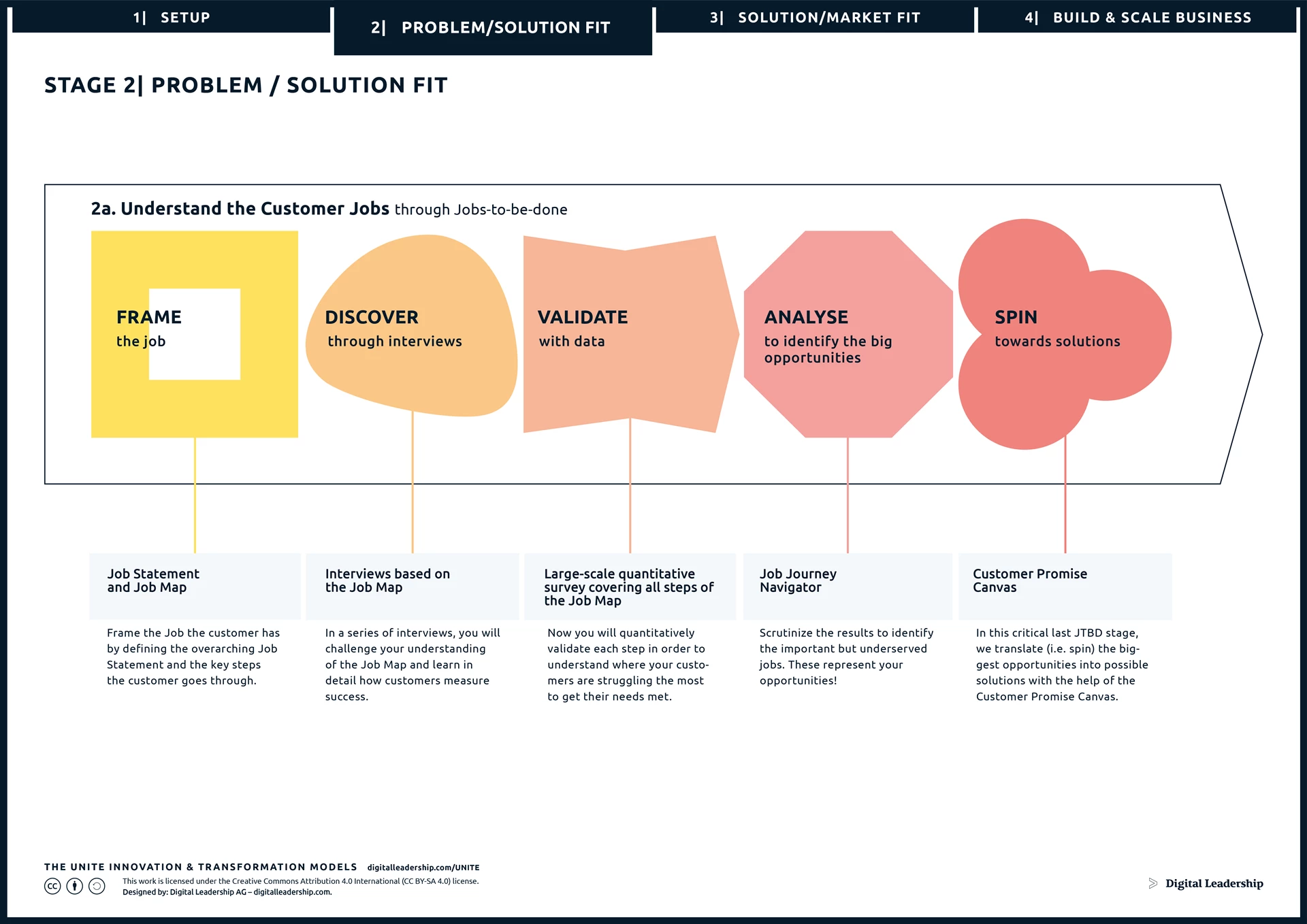
Table of Contents
How should you structure your business most efficiently? The best way to drive transformation and ongoing success in any business is by instituting the Jobs to be Done Framework. The framework enables you to build customer-centric growth and innovation processes to increase customer satisfaction, loyalty, and revenue.
In this article, we discuss the elements of the Jobs to be Done Framework and how they fit into your business’s overall management plan. The framework is just a part of the complete Jobs to be Done Theory. You can find more information about the Jobs to be Done Theory, and the role it plays in innovation and transformation, by visiting: Jobs to be Done Framework, Theory, Examples, and Statements JTBD
Much more about JTBD and other approaches to innovation strategy you will find in our brand-new FREE book “How to Create Innovation”
What Is Jobs to Be Done Framework?
The Jobs to Be Done Framework is a process to understand what pain points your customers are facing. We are seeking to understand important but unmet user needs, not ideas about solutions for customers we do not know yet.
The framework is a series of discrete steps operations take in order to evaluate customer needs and how your business can work to meet them. The framework is the Jobs to be Done Theory in action and practice, a pathway established by the Theory’s philosophy
Jobs to Be Done Framework Steps
There are different approaches to JTBD. We have attempted to take the best from JTBD thinking and model it in one common framework.
There are, however, other approaches that have their merits. Before you embark on a project, we suggest you look further into which approach best fits your needs, and most importantly, do not get too fixated on one approach. Use what is helpful.
Be sure, too, that your leadership team is committed to the philosophy behind the framework. More information about the Jobs to be Done Theory can be found in our recently published article at:
Jobs to be Done Framework, Theory, Examples, and Statements JTBD
The framework proposes five steps for implementing Jobs to be Done, and we outline them as follows:
Step 1: Framing the Job
We frame a Job to be Done using two steps:
- The one-sentence Job Statement helps us articulate all the customer’s needs in a given situation using their voice.
- The eight steps of the Job Map help us discover the smaller tasks and activities customers are doing to accomplish their job.
Customer Jobs Statement
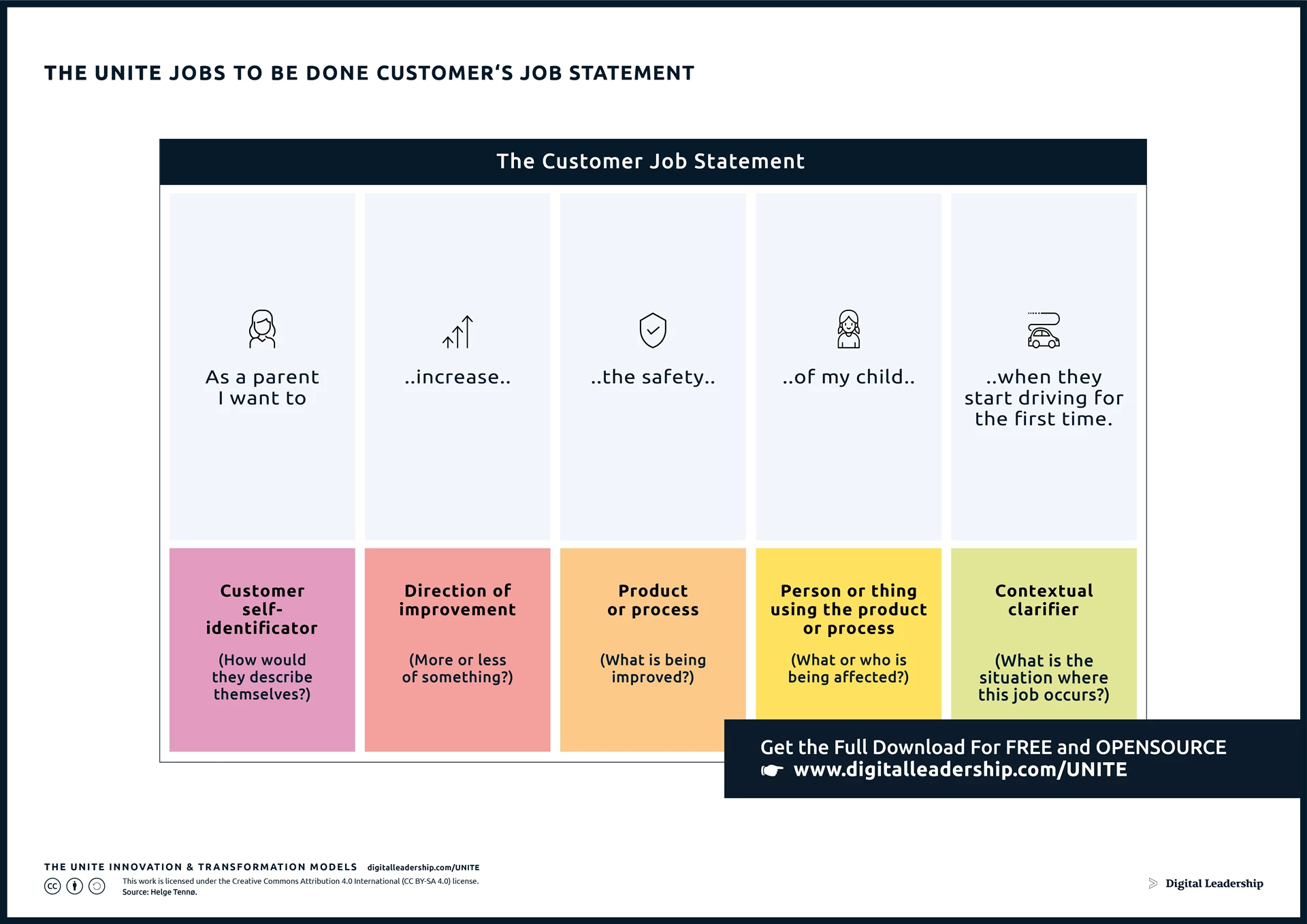
Designed by: Digital Leadership AG – Source: Helge Tennø.
The customer’s Job Statement uses a simple sentence structure using the customer’s own words, describing the outcome he or she is ultimately hoping to achieve or the struggle he or she wants to overcome.
The following sentence structure helps provide clarity:
- The Customer Voice: The statement is to be written from the customer’s perspective using their words and way of seeing the world. Start the statement with how they would identify themselves in this context. For example, “As a parent, I want to …”
- The Direction of Improvement: What is the type of improvement the customer wants? For example, an increase, or a decrease?
- What’s Being Improved: For example, health, taste, efficiency, or safety.
- Who’s Being Affected by the Improvement: For example, ordering produce, planning financial health, finding the right wine, or securing the health and safety of your family.
- Contextual Clarifier: What describes the specific situation the customer is in?
The Job Statement should be simple and direct. It should avoid prejudicing product teams toward one solution or another.
Be aware of some common pitfalls often encountered when writing the Job Statement.
Common mistakes when writing the Job Statement:
- Using your words, not the customer’s: Teams can easily use their own special terms and perspectives. Ask yourself, would a customer use these words to describe their experience?
- Forgetting that the customer is not you: Sometimes we assume the customer already knows the problem we want to solve or the product we haven’t made yet. Be sure the statement reflects the current knowledge and awareness of the customer.
- Losing the full picture: The customer always has a bigger perspective. Make sure not to describe your solution, but the customer’s situation where your future product has a role.
With the customer Job Statement in place, we have successfully brought the customer into the project and achieved alignment in the team about where to focus our efforts. We are ready to move to the next phase: discovering what the customer does when trying to complete their job.
The Universal JTBD Job Mapping
Using the eight steps of the Job Map, we outline the smaller tasks and activities customers are currently doing to accomplish their job.
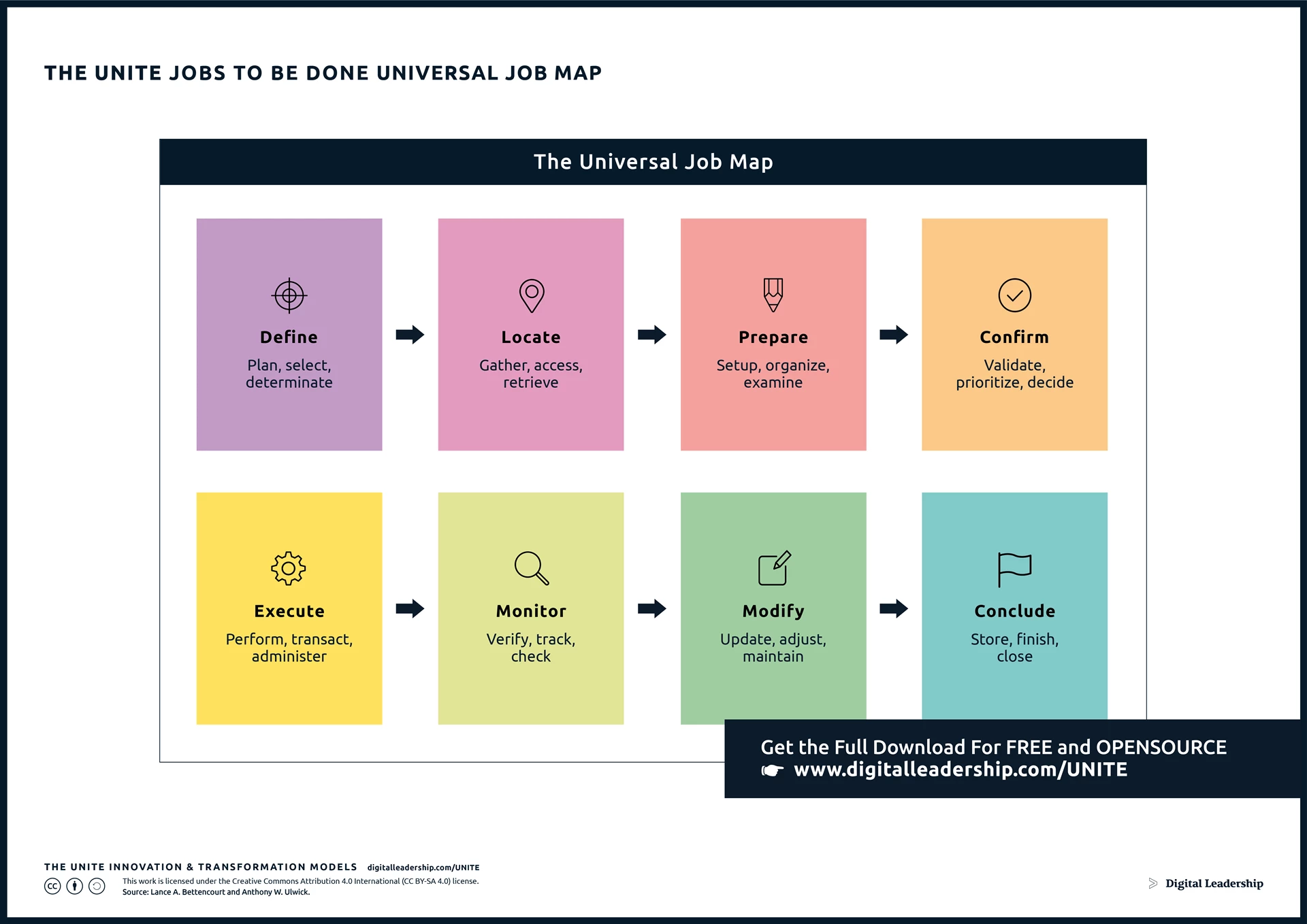
Designed by: Digital Leadership AG – Source: Lance A. Bettencourt and Anthony W. Ulwick.
The 8 Steps in Job Map:
- Define and plan: The customer consciously or subconsciously creates an initial plan for their approach to achieving their goal.
- Locate the input needed: The customer identifies and locates the information necessary for them to decide what to do.
- Prepare: The customer organizes and makes sense of the information, filters and qualifies it, establishes theories, and goes to find more information or chooses to make a decision about what to do.
- Confirm and validate: The customer makes a decision to take action and validates it.
- Execute: The customer performs the action or procedure leading from the decision.
- Monitor: As the decision is executed the customer monitors the effects and outcome.
- Modify: Monitoring creates new information which leads the customer to assess their original decision. Did they make a good decision, or do they need to go back and make a new decision based on their new data? Do they just conclude (move to the next phase), or do they continuously monitor and improve their decision?
- Conclude: In some jobs, the customer concludes at some point that their journey is over. They take stock of their situation based on their assessment from the modify phase and conclude if they were happy or not and learn from it.
These steps aren’t necessarily sequential or linear. That is why it is called a map and not a journey. There might be loops, sending the customer back and forth between the steps. Some of the steps might happen in parallel. Some steps might be intuitive and take seconds to complete, while for others the same step might take weeks or months.
The amount of tasks and activities you will be able to identify depends on the job, but don’t be surprised if you identify 100 or more activities connected with your job.
Different customers will try to solve the job to be done differently. You are not trying to find one optimal way of solving the job at this stage in your process; you want to map out every possible way your customers are trying to solve it so you deeply understand their current approach.
Step 2: Discovering through Interviews
Jobs are not made up: they are discovered. Businesses don’t seek friction, they use innovation processes to address it. We need to learn how this happens.
Qualitative interviews are a cornerstone of Jobs to be Done Theory, and these interviews should be done by your own team. They should be firsthand. This is a great opportunity to leverage a company’s undiscovered voices into a deeper understanding of the organization’s practices.
Initial interviews: Validating the main steps of the job
In the first few interviews, we refine the Job Statement and improve the initial Job Map. The Job Map is best laid out on a wall with Post-it notes so we can easily interrogate it step-by-step.
After a few interviews (on average six, in our experience) and shuffling around the individual steps, the Job Map should stabilize.
Be sure to draw interviewees from all levels of a company’s structure. You may be surprised to find that insightful and dynamic thinking is not limited to the folks with the big offices!
Later interviews: Understanding the Customer’s Criteria
The focus of the subsequent interviews shifts to understanding workers’ mindsets and motivations and collecting the criteria used to assess if a job is well done or not. By thinking about all possible criteria used for evaluation completion, we can best understand all the customer’s needs.
There are three main types of criteria to look out for:
- Functional criteria “Functional Jobs”: Needing more or less of something, e.g., faster, simpler, cheaper, etc.
- Emotional criteria “Emotional Jobs”: Fulfilling needs like reduced stress, increased safety, comfort, personal mastery or accomplishment
- Social criteria “Social Jobs”: Like increased trust, openness, willingness to participate or connection
Everyone will have their own criteria for each step in the Job Map. So, as we go through each step in an interview, we collect the Customer Criteria, with the last interviews increasingly shifting to ensuring completeness and validating accuracy.
Qualitative interviews are a learning journey. We make sure to use the data we uncover to continuously update our questions in order to reflect what we know. We are open to new market insights that could inspire new innovation processes. If we assume we already know the most important questions to ask customers, it exposes our work to a lot of bias and risk.
The UNITE jobs to be done Customer Criteria Template

Designed by: Digital Leadership AG – Source: Strategyn
Step 3: Validate with Data
Having identified the most important Customer Criteria, we now want to quantify these and identify our biggest growth opportunities. In this step, we will undertake a large quantitative survey covering our final 50–150 Customer Criteria. For each criterion, we will ask our target group two important questions:
- What is the importance of this criterion to you, on a scale from 1–5?
- To what degree are you currently satisfied with the options you have to satisfy it, on a scale from 1-5?
The more people we can survey, the more accurate the data will be. Considering how important these insights will be, the investment in the effort here will be rewarded.
Step 4: Identify the Big Opportunities
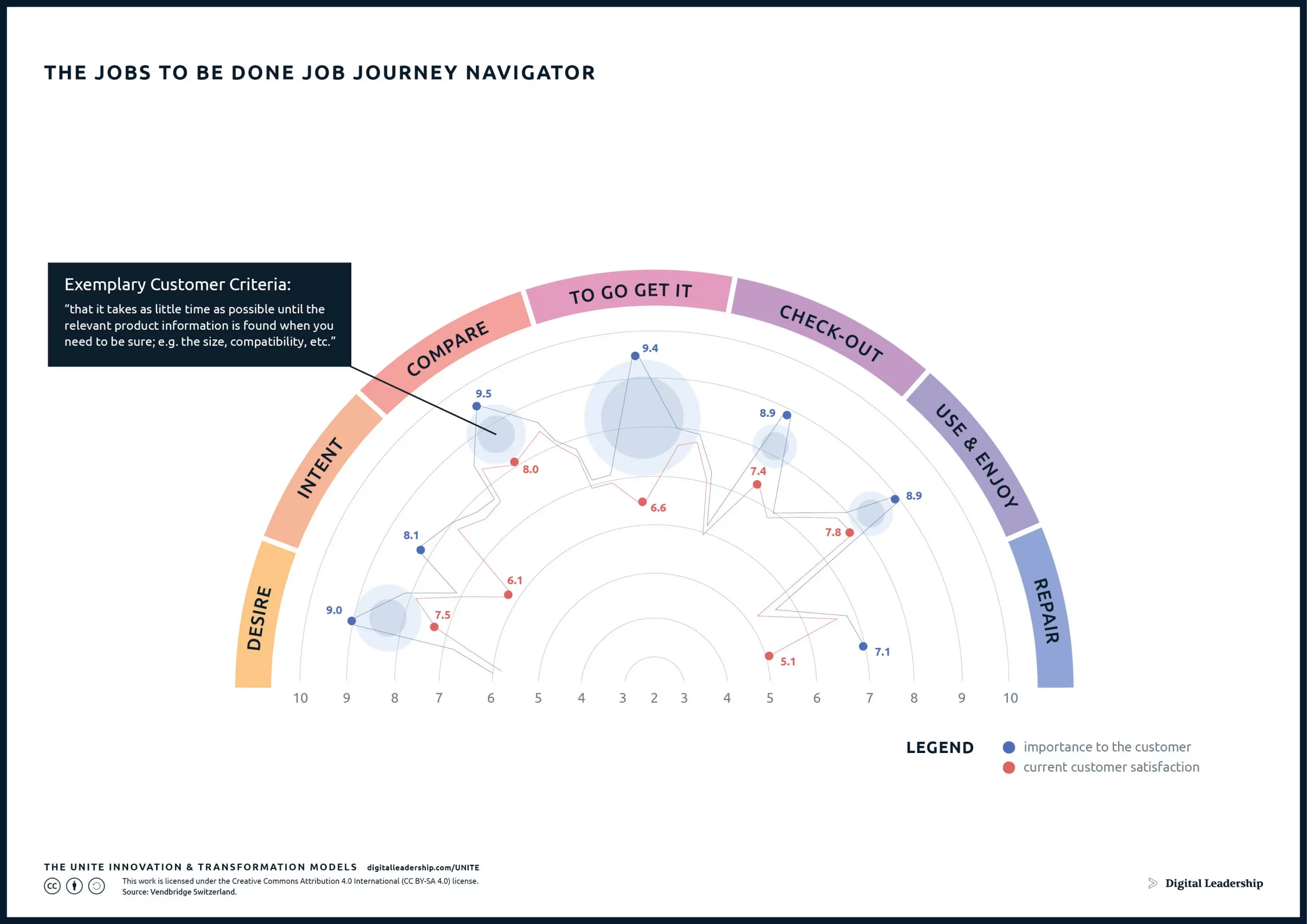
Designed by: Digital Leadership AG – Source: Vendbridge Switzerland.
We will now visualize the results from the survey to make the insights immediately accessible and actionable to the team. The Job Journey Navigator from Vendbridge is one such example of visualization. In it, every Customer Criteria is mapped like a journey, aligned to the Job Map, helping the team easily see where the biggest opportunities lie. This helps support prioritization when we begin to imagine solutions and create products.
Step 5: Spin Towards Solutions
Now it is time to start connecting JTBD with solutions we can provide.
Based on the prioritized opportunities we uncovered using the Job Journey Navigator, we have a selection of needs to reduce to the few that are best addressed with major investments. In this step, we articulate a promise for every one of the opportunities and compare them to each other in order to find which ones best match our capabilities and the innovation journey we can facilitate.
To help visualize our proposed solutions, we use the UNITE Customer Promise Canvas.
The UNITE Customer Promise Canvas
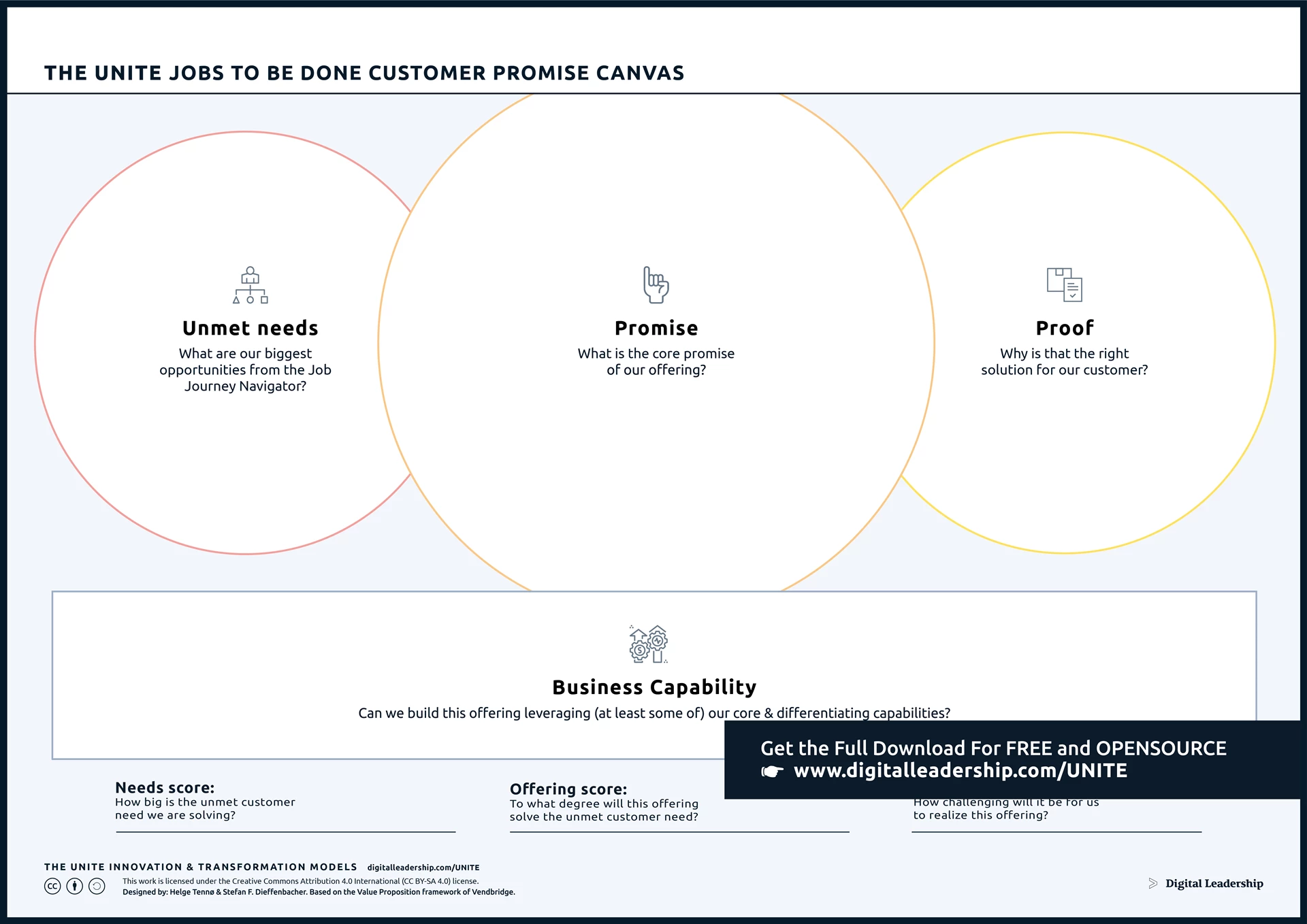
Designed by: Helge Tennø & Stefan F. Dieffenbacher. Based on the Value Proposition framework of Vendbridge
The canvas includes four elements:
Customers Unmet needs
Start here with your prioritized opportunities from the Job Journey Navigator!
Promise
Articulate a high-level promise that responds to the unmet customer need. This promise will later be the basis for a Value Proposition.
Proof
The proof asks you for further verification: Why is your promise to the customer the right solution for their job?
Business Capabilities
We cannot invent promises out of thin air; we have to relate them to our organization and its capabilities. Can we realistically build this? Can we leverage at least some of our core and differentiating capabilities?
You can even turn the UNITE Customer Promise Canvas into a fun competition in your team. Ask two or more people to collaborate on competing promises for the same unmet need, and use the scoring mechanism on the canvas to see who can come up with the simplest way to offer the best promise for the biggest need.
The UNITE Customer Promise Canvas is a way for the team to explore at an initial level how needs can be mapped to promises and which of these are the best fit for your business.
It will help you filter out some of the opportunities and make you even more confident and enthusiastic about the promises you now have left.
What Matters in The Jobs To Be Done Framework?
The #1 problem when it comes to innovation is that we tend to analyze and understand the world entirely from the business’s own perspective. We lack the framework and mental models to include the customer in our conversations and decision-making. This cannot work and we see it in the numbers: most innovation projects fail.
The Jobs to be Done framework foundation for creating value is a deep understanding of, among other things, what “tasks to do” a customer has in particular life situations, how he or she makes decisions about alternatives, what trade-offs are made, whether the “suffering” is so great that solutions are cobbled together and what forces are at work in making decisions for and against selecting new solutions.
A cornerstone of the JTBD Theory is the recognition that customers “commission” products and services that help them complete a task and make progress in their lives. The more precisely one knows the task to be done and the decision-making process leading up to “commissioning” a solution, the more meaningful innovations can be developed. This framework doesn’t just help with strategic decisions, however. Even the question of which product features and functions to develop (and which not to develop) get great clarity when there is an understanding of what tasks a customer wants to be done.
The Jobs to be Done Framework: Closing Thoughts
A framework, any framework, is only as good as the commitment to its philosophy as demonstrated by the day-to-day operations of a company. This is especially true of the Jobs to be Done Framework where so much of a company’s energy is devoted to unpacking and then meeting the needs of its customers. Half measures in this regard are folly. You need to be All In, or All Out. We believe the JTBD Framework gives excellent guidance for growing your business through customer satisfaction. With consistently happy customers, how can you fail?
The UNITE Business Model Framework: A Framework for Innovation Success
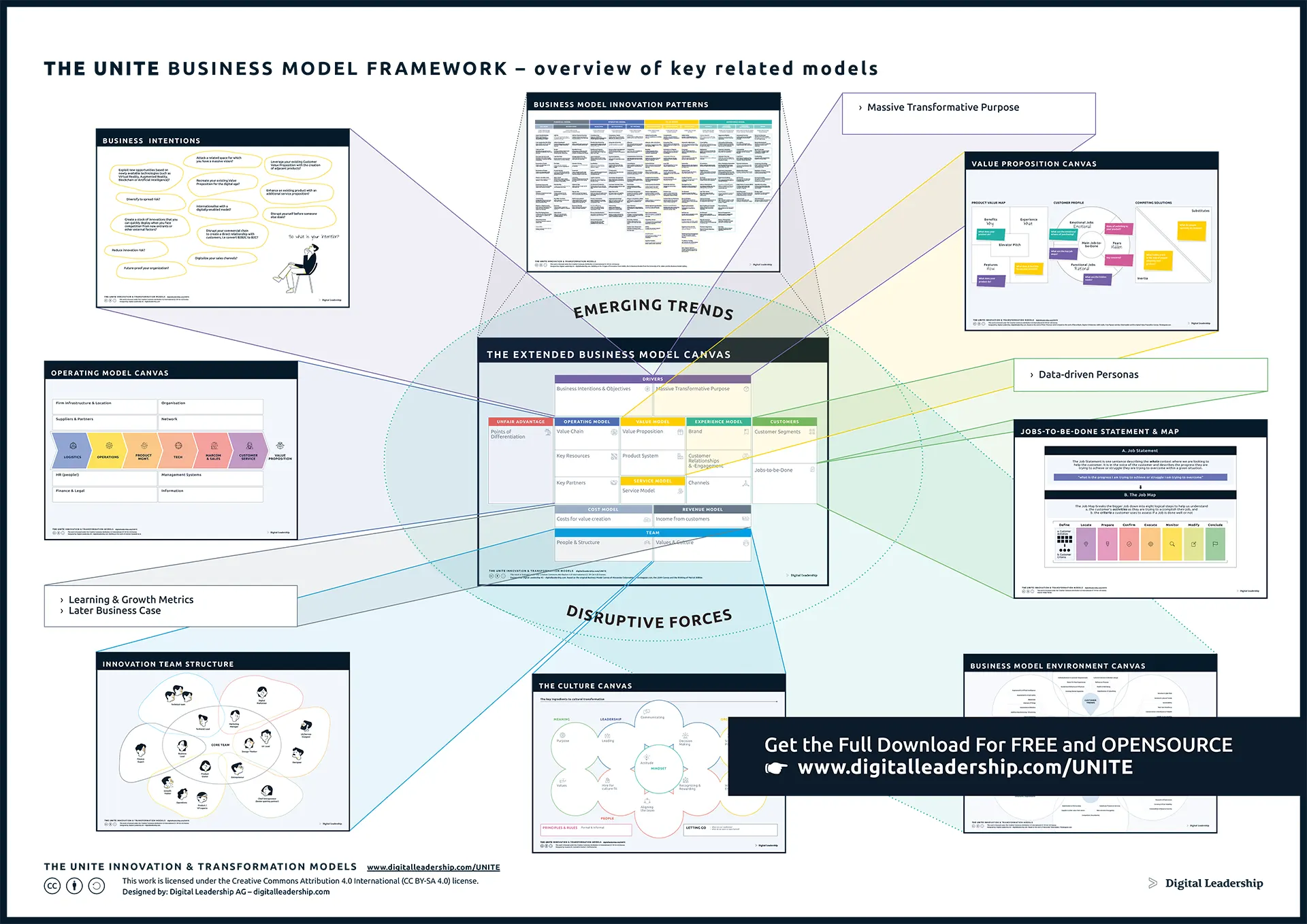
Designed By: Digital Leadership AG

































 Book How to Create Innovation
Book How to Create Innovation